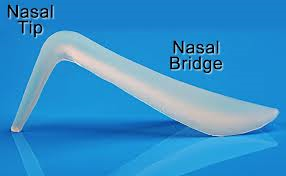
This is, however, good motivation to consider the use of nasal implants. The nose overresected from prior surgery leaves a scooped-out dorsum. (saddle nose) Similar problems can occur from nasal fractures. Asian and African American patients demonstrate a low dorsum and an underprojected nasal tip and often seek cosmetic correction. All of these problems can be fixed by bone and cartilages grafts but it is temptingly easier to use something ‘out-of-a-box’. And because of donor site pain for graft harvest, patients are very willing to go with an easier (notice I didn’t say better) solution.
Implants for the nose use all of the traditional materials such as silicone rubber, Gore-tex, and Medpor. By far, most nasal implants placed around the world are silicone rubber due to low cost, different styles, and easy insertion into the nose. No one implant material has ever been shown to be better than another.
I rarely use synthetic materials in the nose. There is no question they make certain types of rhinoplasty easier but they definitely have more long-term problems. How much more is not really known but I would guess it is likely significant. If you follow these patients long enough, many will likely develop problems even if it is decades later. The dilemma for me is not so much in the reconstructive rhinoplasty (where scarred and damaged tissues make using an implant very precarious so I don’t do it), but in the primary cosmetic rhinoplasty in the ethnic patient. Many need a lot of dorsal, tip, and columellar support and it is so tempting to use an implant as opposed to a large rib graft harvest.
Dr. Barry Eppley
Indianapolis, Indiana


